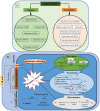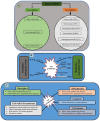The Key Roles of ROS and RNS as a Signaling Molecule in Plant-Microbe Interactions
- PMID: 36829828
- PMCID: PMC9952064
- DOI: 10.3390/antiox12020268
The Key Roles of ROS and RNS as a Signaling Molecule in Plant-Microbe Interactions
Abstract
Reactive oxygen species (ROS) and reactive nitrogen species (RNS) play a pivotal role in the dynamic cell signaling systems in plants, even under biotic and abiotic stress conditions. Over the past two decades, various studies have endorsed the notion that these molecules can act as intracellular and intercellular signaling molecules at a very low concentration to control plant growth and development, symbiotic association, and defense mechanisms in response to biotic and abiotic stress conditions. However, the upsurge of ROS and RNS under stressful conditions can lead to cell damage, retarded growth, and delayed development of plants. As signaling molecules, ROS and RNS have gained great attention from plant scientists and have been studied under different developmental stages of plants. However, the role of RNS and RNS signaling in plant-microbe interactions is still unknown. Different organelles of plant cells contain the enzymes necessary for the formation of ROS and RNS as well as their scavengers, and the spatial and temporal positions of these enzymes determine the signaling pathways. In the present review, we aimed to report the production of ROS and RNS, their role as signaling molecules during plant-microbe interactions, and the antioxidant system as a balancing system in the synthesis and elimination of these species.
Keywords: RNS; ROS; antioxidant system; plant–microbe interactions; signaling.
Conflict of interest statement
The authors declare no conflict of interest.
Figures




References
-
- Al Azzawi T.N.I., Khan M., Hussain A., Shahid M., Imran Q.M., Mun B.-G., Lee S.-U., Yun B.-W. Evaluation of Iraqi rice cultivars for their tolerance to drought stress. Agronomy. 2020;10:1782. doi: 10.3390/agronomy10111782. - DOI
-
- Khan M., Al Azzawi T.N.I., Imran M., Hussain A., Mun B.-G., Pande A., Yun B.-W. Effects of lead (Pb)-induced oxidative stress on morphological and physio-biochemical properties of rice. Biocell. 2021;45:1413. doi: 10.32604/biocell.2021.015954. - DOI
-
- Imran M., Shazad R., Bilal S., Imran Q.M., Khan M., Kang S.-M., Khan A.L., Yun B.-W., Lee I.-J. Exogenous Melatonin mediates the regulation of endogenous nitric oxide in Glycine max L. to reduce effects of drought stress. Environ. Exp. Bot. 2021;188:104511. doi: 10.1016/j.envexpbot.2021.104511. - DOI
Publication types
LinkOut - more resources
Full Text Sources
Research Materials
Miscellaneous

